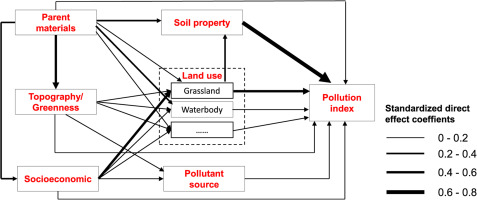Environmental Pollution ( IF 7.6 ) Pub Date : 2020-01-27 , DOI: 10.1016/j.envpol.2020.114075 Cheng Li 1 , Georgina M Sanchez 2 , Zhifeng Wu 3 , Jiong Cheng 1 , Siyi Zhang 1 , Qi Wang 1 , Fangbai Li 1 , Ge Sun 4 , Ross K Meentemeyer 2

|
This three-decade long study was conducted in the Pearl River Delta (PRD), a rapidly urbanizing region in southern China. Extensive soil samples for a diverse land uses were collected in 1989 (113), 2005 (1384), 2009 (521), and 2018 (421) for heavy metals of As, Cr, Cd, Cu, Hg, Ni, Pb and Zn. Multiple pollution indices and Structural Equation Models (SEMs) were used in attribution analysis and comprehensive assessments. Data showed that majority of the sampling sites was contaminated by one or more heavy metals, but pollutant concentrations had not reached levels of concerns for food security or human health. There was an increasing trend in heavy metal contamination over time and the variations of soil contamination were site-, time- and pollutant-dependent. Areas with high concentrations of heavy metals overlapped with highly industrialized and populated areas in western part of the study region. A dozen SEMs path analyses were used to compare the relative influences of key environmental factors on soil contamination across space and time. The high or elevated soil contaminations by As, Cr, Ni, Cu and Zn were primarily affected by soil properties during the study period, except 1989–2005, followed by land use patterns. Parent materials had a significant effect on soil contamination of Cd, Cr, Ni, Pb and the overall soil pollution during 1989–2005. We hypothesized that other factors not considered in the present study, such as atmospheric deposition, sewage irrigation, and agrochemical uses, may be also important to explain the variability of soil contamination. This study implied that strategies to improve soil physiochemical properties and optimize landscape structures are viable methods to mitigate soil contamination. Future studies should monitor pollutant sources identified by this study to fully understand the causes of heavy metal contamination in rapidly industrialized regions in southern China.









































 京公网安备 11010802027423号
京公网安备 11010802027423号